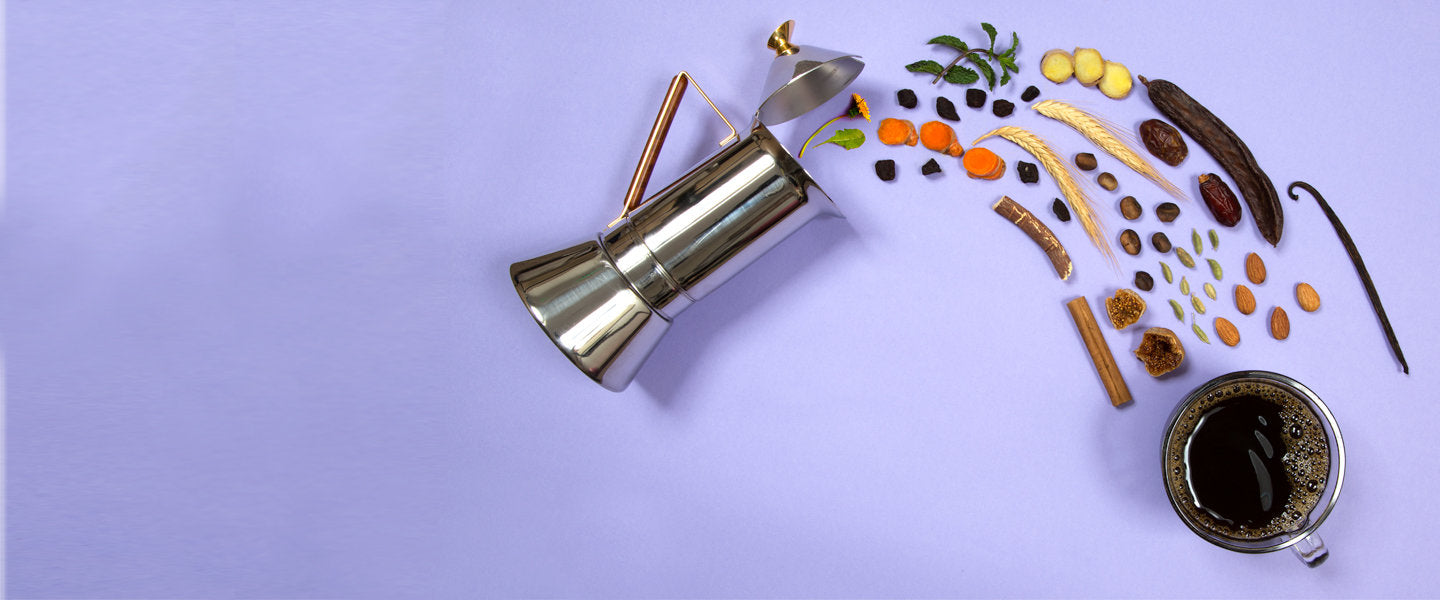Antioxidants
More health benefits:

Antioxidant protection in a cup of Teeccino
If you read about health topics in magazines or newspapers, you will have heard about the importance of antioxidants in slowing or preventing damage to cells caused by free radicals to help prevent chronic disease. Free radicals can cause oxidative stress which has been linked to cancers, heart disease, stroke, Parkinson’s, and other serious conditions.
Many Teeccino ingredients are good sources of a type of antioxidant known as polyphenols – one of the many reasons to incorporate a cup of Teeccino in your daily brewing ritual!
Indirect antioxidants called polyphenols
Vitamin C and E are well known “direct antioxidants” found in foods, meaning that they suppress free radicals but then they are inactivated. They basically have one shot to donate an electron to a free radical to neutralize it. These are the only type of antioxidant officially recognized by the FDA.
However, research now shows that there is a class of “indirect antioxidants” that can reactivate the direct antioxidants and also stimulate the body to produce its own antioxidants over a much longer period of time. These types of antioxidants are called polyphenols.
Two types of polyphenols called flavonoids and oligomeric proanthocyanidins (OPCs) are water soluble, making them instantly absorbable from brewed beverages. Both of these types of antioxidants have been proven to fight free radicals in the human body. They last in the body as long as 72 hours and attach themselves to your cells to protect them from damage. Polyphenols also reactivate spent vitamin C. Teeccino’s ingredients contain both flavonoids and OPCs.
Polyphenols are found in high quantities in herbs such as carob, ramón seeds and dandelion roots, as well as spices, like cinnamon, cloves, and ginger, along with fruits like dates and figs that are all found in Teeccino blends. Commonly eaten foods such as natural (non-alkalized) cocoa powder used in many Teeccino blends, cruciferous vegetables like broccoli and cauliflower, leafy greens like spinach and kale, and other beverages like wine and tea also contain many polyphenols with indirect antioxidant effects.

Carob
Carob, one of the primary ingredients in every Teeccino flavor, contains significant amounts of flavonoids in common with tea such as (-)-Epicatechin 3-gallate, (-)-Epigallocatechin 3-gallate, (+)-Catechin. Carob also contains significant amounts of flavonoids quercetin, kaempferol and myrcetin that are also found in tea. Coffee, on the other hand, has only trace amounts of (-)-Epicatechin and (-)-Epigallocatechin.

Barley, almonds, cocoa powder and dates
Barley, almonds, cocoa powder and dates all contain a variety of proanthocyanidins, a group of antioxidants made famous by being found in grapes, red wine and chocolate. In comparison, coffee only has minimal traces of one type.

Ramón seeds
Ramón seeds, featured in Teeccino’s Maya flavors, have a wide variety of antioxidants including the well-researched (-)-Epicatechin. In two out of three tests of different types of free radical activity, ramón seeds squelched free radicals significantly better than almonds, walnuts and peanuts. Walnuts are commonly thought of as being the nut with the most beneficial antioxidants, so these results show that ramón seeds have a very high level of antioxidant bioactivity.
Figs
Figs have been shown to protect lipoproteins from oxidation and protect blood plasma for up to four hours after consumption. Their antioxidant protection overcame oxidative stress induced by drinking high fructose corn syrup in carbonated sodas. In one antioxidant test, figs produced a better result than green tea!
Teeccino’s antioxidant activity is stronger than coffee’s
The “ORAC” score is used to demonstrate antioxidant activity in foods and beverages. ORAC stands for Oxygen Radical Absorbance Capacity. This series of tests measures antioxidant activity against free radicals that cause aging and can contribute to disease development. It is an easy way to compare the antioxidant potency of one food or beverage to another.
Independent tests by Brunswick Laboratories using the comprehensive ORAC 6.0 assay evaluated the antioxidant capacity of a brewed cup of Teeccino against five primary reactive oxygen species found in humans. Teeccino was shown to have significant antioxidant capacity against all five free radicals. Its total ORAC score ranged between approximately 7,000 – 10,000 µmole TE per an 8-fluid oz cup (236 ml). This is comparable to eating approximately 8 oz of fruits like blueberries and strawberries. Roasted arabica coffee has an ORAC score of approximately 6600 µmole TE per 8 fluid oz cup.
As we suspected, Teeccino’s dandelion flavors had the highest ORAC scores followed by Teeccino’s Maya flavors, which contain ramón seeds. Both dandelion root and ramón seeds have been shown to have high antioxidant capacity in other scientific studies. We were pleased to learn that all of Teeccino’s flavors scored higher than coffee, which is touted as being the best source of antioxidants in the standard American diet.

Antioxidants work synergistically
Researchers now understand that all antioxidants work best in synergy with each other, so it is essential to consume a wide variety of herbs and foods to get a diversity of antioxidants. Indirect antioxidants aid the body in fighting the millions of free radicals produced daily in our cells.



